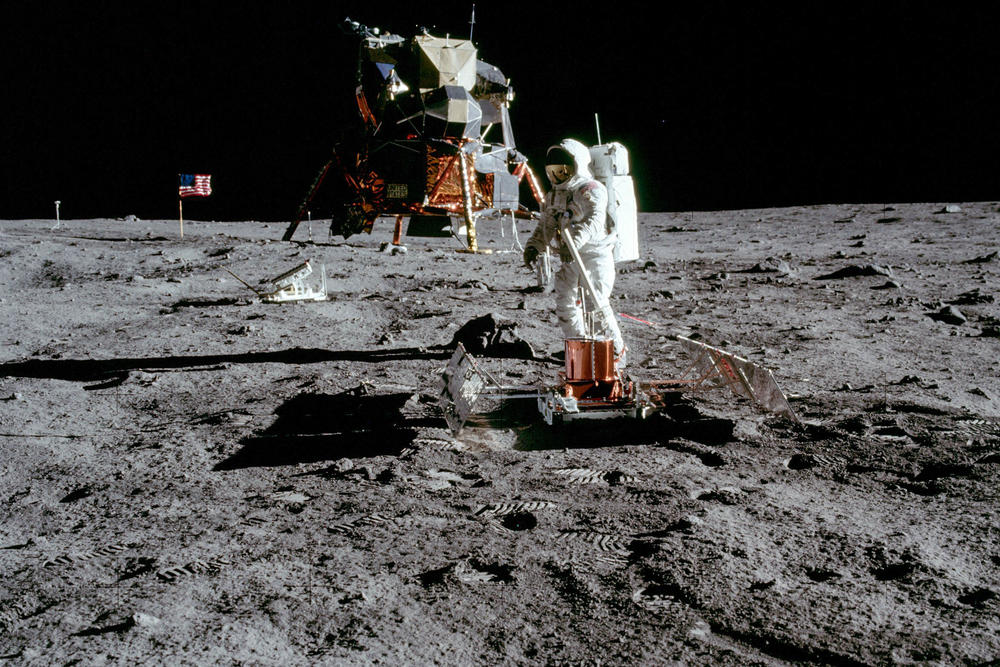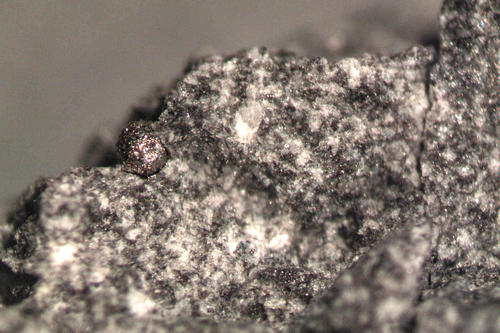“Houston, the Eagle Has Landed”
The first humans landed on the moon 50 years ago. Geologists are still gleaning new insights on how the moon formed and on the early Earth from the rock samples the astronauts collected on their Apollo missions.
Jul 16, 2019
Man on the moon: Astronaut Buzz Aldrin set up a laser reflector and a seismometer on the surface of the moon. The lunar module and the American flag are seen in the background. The picture was taken during the Apollo 11 mission in 1969.
Image Credit: NASA
Do you remember? It was late afternoon on July 20, 1969. Many Baby Boomers had just come home from school to find their mothers staring at the TV, transfixed. Grainy black-and-white photos flickered across the matte screen, accompanied by snatches of speech and a lot of static noise. And Mom called out ecstatically, “Look, honey! We’re landing on the moon!”
Some 600 million people are estimated to have been watching live in living rooms around the world that day, when Neil Armstrong, commander of the Apollo 11 mission left the lunar module Eagle, followed by Buzz Aldrin, for the first-ever walk on the moon. “That’s one small step for a man, one giant leap for mankind,” Armstrong said as his feet sank into the dust on the moon’s surface – not knowing that this sentence would go on to be as famous as Martin Luther King’s “I have a dream.”
The astronauts spent just under 22 hours in Mare Tranquillitatis, the “Sea of Tranquility,” a crater 835 kilometers wide. Meanwhile, the third man, Michael Collins, held down the fort in orbit on the command module, Columbia. When the mission was completed the next day, with a picture-perfect landing in the Pacific, the three men had achieved the task that John F. Kennedy had set for his nation in 1961: sending a person to the moon and safely back home to Earth before the decade was out.
Lunar Rock Is Provided to Researchers Free of Charge
Along with the passengers, the landing capsule was also bringing eagerly awaited cargo with it when it splashed down: eleven kilograms of rock from the moon. It wasn’t much to look at, but it has been a priceless trove of information for researchers right up to the present day. Over the six successful Apollo missions, 2,415 lunar samples weighing 382 kilograms in all were brought back to Earth – from fine, loose moon dust and chunks of rock weighing several kilograms to soil profiles several meters deep.
The lunar rocks were studied back in the 1970s, using methods that were state-of-the-art at the time. But the U.S. National Aeronautics and Space Administration (NASA) also had the foresight to realize that it would take future generations of researchers to develop methods that enable more accurate analysis of the samples and improved interpretation. “Some of the lunar samples have remained untouched to this day as a result. They are stored in a protective atmosphere inside sealed containers at the Lyndon B. Johnson Space Center in Houston,” explains Professor Harry Becker, a geochemist at Freie Universität Berlin.
Becker has been working on the cosmochemistry of meteorites and, later, the moon since 1997. In front of him lie sealed samples taken on the Apollo 15, 16 and 17 missions: rock fragments the size of sugar cubes, and some that are no larger than pebbles. One gram, or less often a few grams in weight – NASA won’t part with more. A numerical code indicates the mission number, the place where the sample was taken, and further details. Lunar rock from the Apollo missions is priceless – which is why NASA doesn’t charge to provide it to selected researchers around the world.
Becker and his colleagues from Freie Universität Berlin and Technische Universität Berlin, the Museum für Naturkunde Berlin, the German Aerospace Center (DLR), and the University of Münster are studying various things as part of collaborative research center Transregio 170, “Late Accretion onto Terrestrial Planets,” most especially the late phase of Earth’s formation.
“The formation of the moon is a key part of this,” Becker says. This is the phase when the planets that make up our solar system were still relatively “young” and when they were under heavy bombardment from small planets and asteroids. It was then that a “protoplanet” called Theia, which was about the size of Mars, crashed into Earth. The massive impact produced great heat and spewed gas and molten rock in all directions. These materials initially collected in orbit around Earth. A few hundred years later, they had balled together to form the moon. That is the most widely held hypothesis today.
Earth Older than Moon
Scientists suspected right away after their initial study of the samples brought back by the Apolllo 11 mission that the young moon must have been home to a global ocean of magma when it first formed. Earth wasn’t in much better shape, either. “Depending on the angle of impact and Theia’s mass, the temperature on Earth was anywhere from 2,000 to over 5,000 degrees Celsius,” Becker says. “At least part of Earth was covered by a magma ocean at the time.”
How did this huge collision affect Earth’s further development? Did water, carbon, and sulfur first come to Earth in the impact? Or did they already exist there beforehand? The cratered landscape of the moon gives an impression of how our own planet must have looked at some point in the past.
“On Earth, plate tectonics causes the majority of the planet’s surface to be replaced every 150 to 200 million years. On the continents, we do still have parts of the earth’s crust that are as much as four billion years old. But Earth is older than the moon,” Becker explains. “So we’re missing a key piece of Earth’s early history. That’s what makes it so important to study other celestial bodies, like the moon.”
The tiny ball of ferrous metal that researchers from Freie Universität laid bare from within the moon rock debunks theories that the moon landing was a hoax.
Image Credit: Freie Universität Berlin
The moon is estimated to be about 4.5 billion years old. But it isn’t clear how quickly the magma ocean cooled down. Scientists previously thought this took place within ten million years. “But our colleague Doris Breuer of the DLR has found, using simulations, that it could also have taken 100 to 200 million years,” Becker says. That would explain what had been a puzzling gap between the event and the oldest lunar rocks that have been dated, which date back to 4.35 to 4.4 billion years.
“Only after magma has crystallized into rock can it be dated using the natural radioactive decay of certain elements present in the material.” This is the time when rock is born, so to speak, which geologists can trace later on using isotope measurements. It is only in the last few years that it has become possible to use ion beams to shoot tiny areas just a few micrometers across out of thin sections of lunar rock and subject them to chemical analysis, thereby producing extremely accurate dates.
Asteroids Left Gigantic Impact Craters
The face of the moon changed radically at first, but has remained largely unchanged in recent times. And just like Earth itself, cosmic dust and countless meteor impacts mean that it continues to gain mass. The moon is dotted with craters. In some cases, large asteroids left vast impact craters such as Mare Imbrium. Measuring 1,146 kilometers in diameter, it stretches over an area twice as large as Germany.
Earth faced even heavier bombardment. But unlike the moon, Earth developed an oxygen-rich atmosphere later on, and it has large oceans. That’s also why there is “weather” here: wind, rain, and thus also erosion. In addition, the biosphere, which is constantly emerging and decaying, is also constantly generating new soil, which covers the impact scars.
And yet, in geological time, the last major impacts occurred just recently. The impact that formed the 25-kilometer Nördlinger Ries crater, on the edge of the Swabian Jura, took place “only” 14 million years ago. “The asteroid that formed this feature was probably about one kilometer in diameter. The impact melted rock into glass and flung it as far away as the Czech Republic,” Becker says. “You can imagine what an event like that would mean for an industrialized country today.”
But that was nothing compared to the impact on Mexico’s Yucatán Peninsula 66 million years ago, which is likely to have contributed to the extinction of the dinosaurs. The crater there, which is mostly eroded and covered by sediment today, is 150 kilometers wide. Even so, that makes it quite a bit smaller than the Vredefort crater, in South Africa, which measures 320 by 130 kilometers. It was formed two billion years ago.
“These kinds of impacts can occur over and over, at larger time intervals,” Becker points out. But even smaller asteroids are not harmless, which is why the various space agencies maintain an active observation program. “The little ones don’t do as much damage, but we also don’t discover them until much later.” Unlike in the Hollywood movie Deep Impact, the authorities on Earth would not send out a manned spacecraft on a mission to break up the flying body and neutralize the threat. “If a body like that is far enough away, it’s enough to crash a probe into it and nudge its flight path so it misses the Earth.”
Facts Show: Humans Have Been on the Moon
Even though some people may doubt it, there are many geological facts showing that humans landed on the moon. There are the rock samples from the impact craters, for one thing. In large impacts, part of the moon’s crust melted, and the ferrous metal from the asteroid formed tiny spheres. “In comparable impacts on Earth, the metal oxidizes extremely fast due to the oxygen in our atmosphere,” Becker explains. “But in the rocks from the moon, we find these tiny metal globules that have not undergone weathering in four billion years.” Yes, indeed – we were up there.
This text originally appeared in German on June 8, 2019, in the Tagesspiegel newspaper supplement published by Freie Universität.
Further Information
Prof. Dr. Harry Becker, Department of Earth Sciences, Institute of Geological Sciences, Geochemistry, Tel.: +49 30 838 706 68, Email: hbecker@zedat.fu-berlin.de


